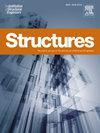工字钢与活性粉混凝土粘结滑移性能研究
IF 3.9
2区 工程技术
Q1 ENGINEERING, CIVIL
引用次数: 0
摘要
本文研究了不同影响条件下钢筋活性粉末混凝土(SRRPC)结构的粘结滑移性能。考虑覆盖厚度、钢锚长度、箍筋间距、含钢量、隔震方式等参数的影响,对23个试件进行了推出试验。试验结果表明:(1)混凝土覆盖厚度是影响最显著的参数,其次是锚固长度和含钢量,箍筋间距的影响相对较小。当覆盖厚度从40 mm增加到100 mm时,极限和残余粘结应力分别增加了84.06 %和129.35 %。(2)通过分析不同参数下的试验数据,得到了应力和滑移的计算公式。(3)覆盖层厚度对摩擦比影响较大,其他参数(锚固长度、箍条间距、钢含量)影响较弱。(4)随着盖板厚度和钢含量的增加,耗能增大,而随着箍筋间距的增大,耗能减小。(5)建立了反映界面应力-滑移情况的本构模型,为SRRPC结构的力学性能分析提供了重要的参考。本文章由计算机程序翻译,如有差异,请以英文原文为准。
Research on bond-slip behavior of I-shaped steel and reactive powder concrete
This paper presents the bond-slip behavior of steel reinforced reactive powder concrete (SRRPC) structures under different influencing conditions. Push-out tests were conducted on 23 specimens by considering the effects of parameters such as cover thickness, anchor length of steel, stirrup spacing, steel content, and isolation mode. The test results indicated that: (1) The concrete cover thickness is the most significant influencing parameter, followed by anchorage length and steel content, while the effect of stirrup spacing is relatively small. The ultimate and residual bond stress increased by 84.06 % and 129.35 %, respectively, as the cover thickness increased from 40 to 100 mm. (2) Formulas for calculating stress and slippage were obtained by analyzing the test data under different parameters. (3) The cover thickness had a great influence on the friction proportion, while the other parameters (anchorage length, stirrup spacing and steel content) had a weak effect. (4) As the increase of cover thickness and steel content, energy dissipation increases, while as the stirrup spacing increases, energy dissipation decreases. (5) A constitutive model was developed to reflect the interfacial stress-slip situation, which provided significant insights into the mechanical performance analysis of SRRPC structures.
求助全文
通过发布文献求助,成功后即可免费获取论文全文。
去求助
来源期刊

Structures
Engineering-Architecture
CiteScore
5.70
自引率
17.10%
发文量
1187
期刊介绍:
Structures aims to publish internationally-leading research across the full breadth of structural engineering. Papers for Structures are particularly welcome in which high-quality research will benefit from wide readership of academics and practitioners such that not only high citation rates but also tangible industrial-related pathways to impact are achieved.
 求助内容:
求助内容: 应助结果提醒方式:
应助结果提醒方式:


